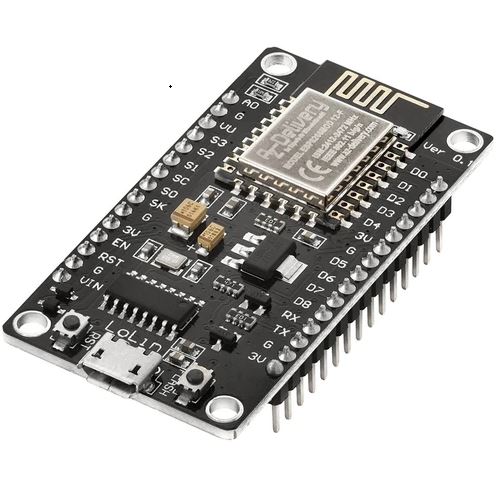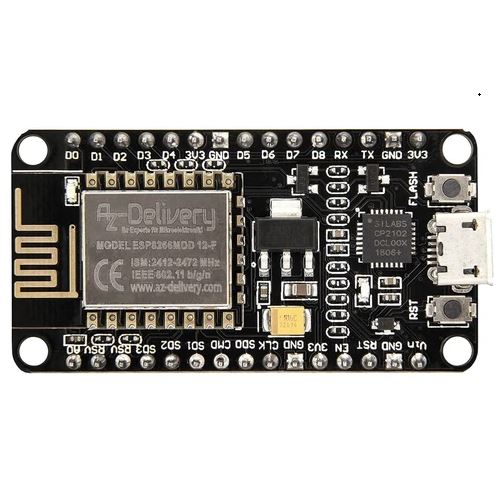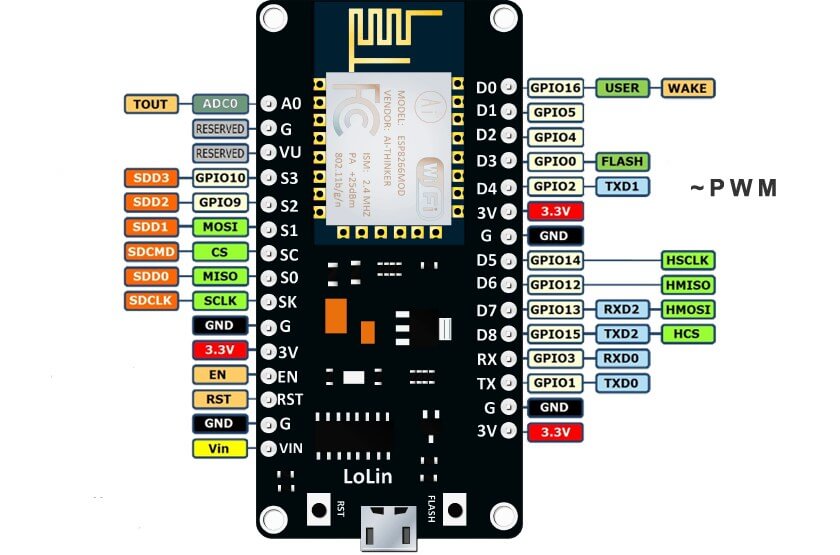The NodeMCU ESP8266 is a microcontroller with an integrated Wifi module. Very easy to use, it’s lightweight and has a memory and calculation capacity superior to that of the Arduino. Ideal for your connected projects.

Microcontroller features
The NodeMCU ESP8266 microcontroller uses the Tensilica 32-bit RISC CPU Xtensa LX106 microprocessor. This processor operates at a clock frequency of 80 MHz. It has 64 kB RAM, NC kB EEPROM and 4000 kB Flash memory (for programming and data logging).
|  |
The microcontroller has a Wifi chip that enables it to connect to the local network, create a server or set up its own network so that other devices can connect to it.
Power supply
The NodeMCU ESP8266 microcontroller operates over a voltage range of 7-12V, thanks to its on-board voltage regulator, while the microprocessor operates with a voltage of 3.3V. In normal operation, the microcontroller consumes up to 45mA (if no power is supplied) and can accept a maximum current of 40mA on each of its IO pins.
Pinout
- Analog I/O : 1 (A0)
- Digital I/O : 5 (D0, D1, D3, D4, D7)
- PWM pins: 4 (D2, D5, D6, D8)
- Communication Serial: 10 (D0, D1, D2, D3, D4, D5, D12, D13, D14, D15)
- I2C communication : 1 ((‘D1’, ‘D2’))
- SPI communication: 1 ((‘D8’, ‘D5’, ‘D6’, ‘D7’))
- I2S communication: 1 ((‘D15’, ‘D2’, ‘D3’))
- Interrupt: 6 (D1, D2, D5, D6, D7, D8)

Basic code and pin identification
const int analogPin = A0; const int digitalInPin = D1; // broches D1, D2, D5, D6,D7 const int digitalOutPin = D2; // D1 à D7 const int pwmPin = D4; // broches D1 à D8 int analogVal = 0; int digitalState = LOW; int pwmVal = 250; void setup() { Serial.begin(115200); pinMode(analogPin, INPUT); // Argument OUTPUT, INPUT pinMode(digitalInPin, INPUT); pinMode(digitalOutPin, OUTPUT); } void loop() { analogVal = analogRead(analogPin); // return int digitalState = digitalRead(digitalInPin); // return boolean digitalWrite(digitalOutPin, HIGH); // valeur LOW(0) ou HIGH(1) analogWrite(pwmPin, pwmVal);// valeur 0-1023 }
For more information on pinout usage, please visit the ESP8266 Pinout Reference page.
Summary of features
| Microcontrôleur | |
| Nom: | ESP8266 |
| Marque: | Espressif |
| Caractéristiques | |
| CPU: | Tensilica 32-bit RISC CPU Xtensa LX106 |
| Tension d’alimentation : | 7-12V |
| Tension logic: | 3.3V |
| E/S digitales: | 16 |
| Entrées analogiques: | 1 |
| Flash: | 4000kB |
| SRAM: | 64kB |
| EEPROM: | NCkB |
| Fréquence d’horloge: | 80 MHz |
| Wifi: | Yes |
| Bluetooth: | No |
| SD card: | No |
| Touch: | Yes |
| UART/SPI/I2C/I2S: | Yes/Yes/Yes/Yes |



